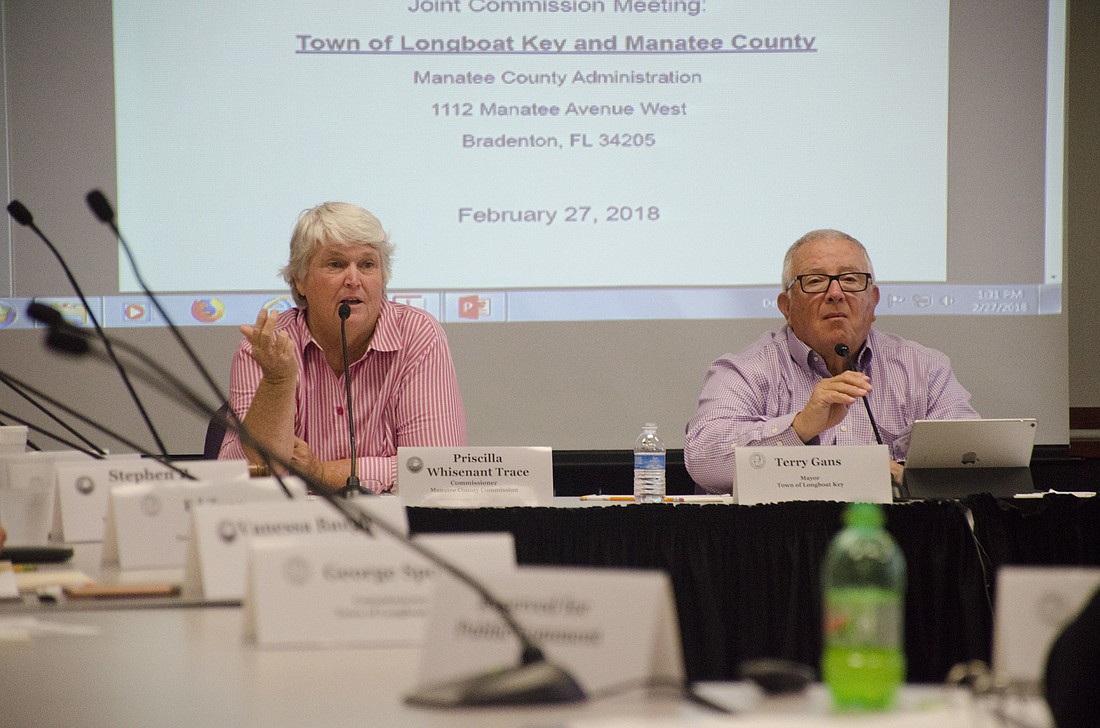- April 16, 2024
-
-
Loading

Loading

It has been years since the two boards last met, and much has happened in the meantime.
A hurricane hit; the town’s approved a project to put all overhead wires underground; traffic hasn’t gotten better; engineers have a plan to make Gulf of Mexico Drive more attractive; Greer Island has moved and beaches have eroded; and one town manager took over for another.
All of those subjects, and more, were discussed at a Manatee County and Longboat Key joint commission meeting Tuesday, a special event that happens every few years, according to the Longboat Key town manager’s office.
Town Manager Tom Harmer has carried a baton passed to him by former Town Manager Dave Bullock in the form of, among other things, proposing the Key move into one county.
Manatee County Commission Chairwoman Priscilla Trace moved this item from the end to the beginning of the meeting to address the “elephant in the room.”
“In my term, we’ve had a more positive level of responsiveness as a partner with Sarasota County than with Manatee,” Mayor Terry Gans said at the meeting.
The island is split near Bayfront Park between the two jurisdictions. Longboat residents in Manatee County pay a higher tax rate than those in Sarasota County. Two counties also complicate matters at Town Hall, like coordinating elections or park management.
“To me, this is like a business thing, and that’s what it’s sounding like it’s going to be about: money,” said Manatee County At-Large Commissioner Carol Whitmore.
Town commissioners and staff presented the idea of moving to one county at a joint meeting with Sarasota County in November, a proposal that was welcomed at last year’s meeting.
Town staff have had preliminary discussions about the difficulties of being in two counties and how the island might fare in either Manatee or Sarasota counties, which would take an act of the state Legislature.
“Our mind is not made up in one way or another,” Gans said.
The island also seeks financial help to stabilize Greer Island on the north end of the Key.
Longboat commissioners hope to secure the sand spit, colloquially known as Beer Can Island, owned by Manatee County. District 5 Commissioner Ed Zunz said the many requests from the town have fallen on deaf ears.
“It’s a source of a significant part of our beach budget to deal with the problems on Greer Island,” Zunz said.
Town staff have proposed three rock groins, and enough sand to fill the space between them, for the north end of the island. This project could cost more than $9 million, according to estimates proposed by town staff.
Manatee County Administrator Ed Hunzeker suggested he and Harmer get together with engineers to decide what is the best option for protecting north end residents of Longboat Key.
Harmer and Public Works Director Isaac Brownman also pitched a regional nourishment collective, which was first proposed by Bullock in November. Each municipality in the region now bids for beach nourishment projects. Permitting takes months, if not years, and transporting and placing sand costs millions of dollars.
The local municipalities compete for who gets what sand, so Bullock suggested they all work together.
“We should work together for the benefit of economics of scale,” said Manatee County Parks and Natural Resources Director Charlie Hunsicker. “We can cooperate.”
Road congestion has always been a problem for the island, particularly in the winter months. The Florida Department of Transportation and the barrier islands are trying to fix that.
That’s all part of the Barrier Island Traffic Study, at least the fifth of its kind, that FDOT has been researching for more than half a year now. State officials have proposed dozens of solutions as they reach the final stage of the almost $1 million study: a traffic management plan.
Some of those proposed changes involve Manatee County, such as an adaptable third lane on the Cortez Road Bridge and an analysis of the impacts of the traffic circles.
Longboat also proposes adding two traffic circles to the Key, one at either end of the island, as part of a project to beautify and enhance Gulf of Mexico Drive.
The plan, which cost the town more than $250,000 to prepare, includes landscaped medians, multiuse paths with low lighting on either side of the state road, enhanced bus shelters (proposed before Route 18, which services Longboat, was slated to be canceled later this year), benches along the paths and a designated bike lane separated from the main drive.
Longboat commissioners attended a Hurricane Irma “Lessons Learned” regional study where former FEMA director Craig Fugate offered suggestions about how the area can better mitigate the impacts of one of Florida’s most common natural disasters.
Town staff, in its presentation before the Manatee and Longboat Key commissioners, are scheduled to suggest the two work to improve shelter processes, debris collection, pre-storm agreements and coordinated utility shutoff timing.
Longboat Key relies on Manatee County for drinking water and waste water treatment, so coordination with Manatee on when to potentially shut off service is a crucial bit of communication.
The town also presented a project it has been spearheading since November 2015: putting all overhead wires underground. The project, which will cost the town more than $49 million, could improve safety and reliability in strong winds — with wires underground, there’s little worry they’ll be severed.
The town is planning to bury all its overhead wires by the end of 2021. The first stage of the project is scheduled to begin in the summer or fall.
Updated Wed., Feb. 28, at 9:37 a.m.